Ijraset Journal For Research in Applied Science and Engineering Technology
- Home / Ijraset
- On This Page
- Abstract
- Introduction
- Conclusion
- References
- Copyright
Night-Flowering Jasmine: A Review of Its Morphology and Pharmacological Activity
Authors: Leena Tamnar, Komal Bhoir, Akshada Vartha, Rahul Jagdale
DOI Link: https://doi.org/10.22214/ijraset.2024.64702
Certificate: View Certificate
Abstract
Known by many as Parijat or Night flowering Jasmine, Nyctanthes arbortristis is a mesmerising plants that are native to the subcontinent of India. This review paper provides an extensive summary of the medical, botanical, and Nyctanthes arbortristis\'s decorative attributes based on the body of current literature. The plant qualities of the plant, such as its distribution, growth patterns, and morphology are outlined. Nyctanthes\'s therapeutic qualities arbortristis, which have been thoroughly studied observed in a number of studies, are investigated. These characteristics include analgesic, a anti-inflammatory, and hepatoprotective, antiviral, antioxidant, and antitumor actions. Additionally, the decorative application of Nyctanthes The discussion of an rbortristis emphasises its beauty attractiveness and potential for gardening and landscaping objectives. The purpose of this review paper is to offer a thorough comprehension of the diff erent features that make Nyctanthes arbortristis function as a useful.
Introduction
I. INTRODUCTION
Rigveda, this subcontinent's oldest information archive, contains the earlies The mention of traditional medicine. Subsequently, Ayurveda emerged as the foundation for all medicinal science systems, derived from the Vedic notion of life. Over time, it assimilated into the culture and the cultural legacy of the Indian subcontinent's population. "Phyto" is the Greek word for plant, and compounds Plants produce substances known as phytochemicals, or fight-o-chemicals[1]. Using plants for therapeutic purposes has been recorded for a very long time in historical literary works. The night-flowering jasmine, Nyctanthes arbortristis, is a native of northern India and southern Asia and a member of the Oleaceae family. With flaky grey bark, it is a tiny tree or shrub that can reach a height of 10 metres. The simple, opposing leaves measure six to Twelve cm in length and 2– 6.5 cm in width. The complete margin and provide beneficial therapeutic qualities. The fragrant flowers have 5 to 8 lobes. White corolla tube with orangered core; two to seven clusters are generated. individually, with each flower blooming from twilight to dawn. The blossoms and seeds and leaves have antiviral, hepatoprotective, antileishmanialimmunostimulant and antifungal properties (Puri and colleagues, 1994) [2] .The woody perennial is terrestrial and can live anywhere from five to twenty years. It is mostly a shrub or small tree with beautiful, wonderfully aromatic foliage that blooms at night and fades before daylight, leaving the ground below in a pleasing mix of crimson and white. Consequently, the plant gradually loses all of its brightness and is called an arbortristis, or "Tree of Sadness." . It is also known as Coral Jasmine, Parijat, Harsinghar, Queen of the Night, and Night Blooming Jasmin [3] .
II. PLANT EXPLANATION:[4]
Name of the plant in various language
Sanskrit Name: Parijatha
Hindi Name: Harsingar
Gujarati Name: Jayaparvati
Bengal Name: Sephalika
Malayalam Name: Parijatakam
Telugu Name: Pagadamalle
English Name: Night Jasmine
Marathi Name: Parijathak
Oriya Name: Gangasiuli
III. PLANT INFORMATION
KoWith flaky grey bark, Nyctanthes arbortristis can grow up to 10m (33 ft) in height as a shr ub or small tree. The leaves have a complete border, are opposite, simple, and are 612 cm ( 2.44.7) in length and 26.5 cm (0.792.56) in width[5] It is found throughout the Terai tracts, as well as in Burma and Ceylon, and grows throughout the IndoMalayan region. It typically grows as undergrowth in arid deciduous forests and can withstand moderate shade [6]. N. arbortristis Linn. (NAT) is a small tree or shrub with a grey, flaky bark that can reach a height of 15 to 20 feet. In warm, humid climates, it is a spermatophyte that is incredibly common. Its stem and branches have a rather square form. The brown, tough stem bark has white do ts on it [7].The plant grows best in well-draining, sandy soil, ideally somewhere with plenty of room for its roots to unfold. It is also found in open forest margins, the edges of stems, and shrublands. Young twinges are thinly finely hairy, and branches are erect or drooping,
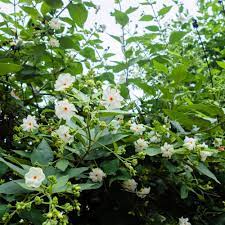
Fig 1: Night Jasmine Plant
IV. TAXONOMICAL CLASSIFICATION: [8]
- Kingdom of plant: Plantae
- Subkingdom of plant: Viridiplantae
- Infrakingdom of Plant: Streptophyta
- Division of Plant: Tracheophyta
- Super division of Plant: Embryophyta
- Sub division of Plant: Spermatophytina
- Class of Plant: Magnoliopsida
- Order of Plant: Lamiales
- Family of Plant: Oleaceae
- Genus of Plant: Nyctanthes
- Species of Plant: Nyctanthes arbortristis
- Binomial Name of the Plant: Nyctanthes arbortristis
V. MORPHOLOGICAL CHARACTERISTICS
A. Leaves
Nyctanthes arbor-tristis leaves: Ayurvedic medicine uses the leaves of this plant to cure a wide range of conditions, such as internal worm infections, Sciatica, persistent fever, and rheumatism. Additionally, they are Utilised as a diuretic, laxative, and diaphoretic medication. To Reduce coughing, use leaves. To relieve a cough, use leaves Sugar and extract are mixed together and given three Few times each day. When treating a disease, elevated blood Leaf paste is used to treat diabetes, high blood pressure, and Dear. The juice of the leaves has laxative and diaphoretic properties.
Diuretic, tonic with a hint of bitterness, and antidote to reptile Poisons. Furthermore, leaves function in the spleen. Expansion. Leaf extract is applied to the management of Piles, persistent fever, intractable sciatica, rheumatism, Intestinal worms, biliary diseases, liver issues, and loss Of hunger and temperature [9,10,11] .
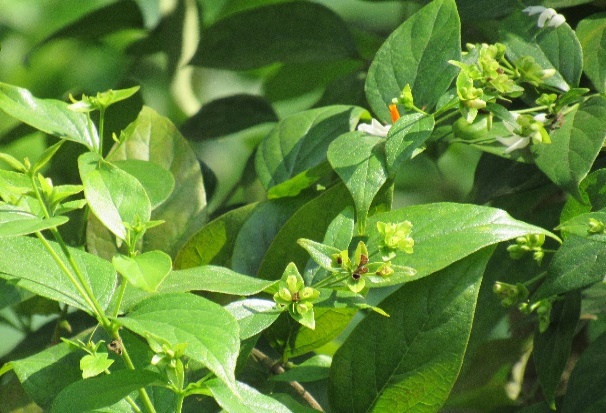
Fig 2: Night Jasmine Leaves
B. Seeds
The seeds are applied to alopecia and used as anthelmintics. In addition to being expectorant and antibilious, it helps with bilious fevers. The seeds are ground up and used to treat scurfy ailments. of the scalp, acne, and skin conditions [12].
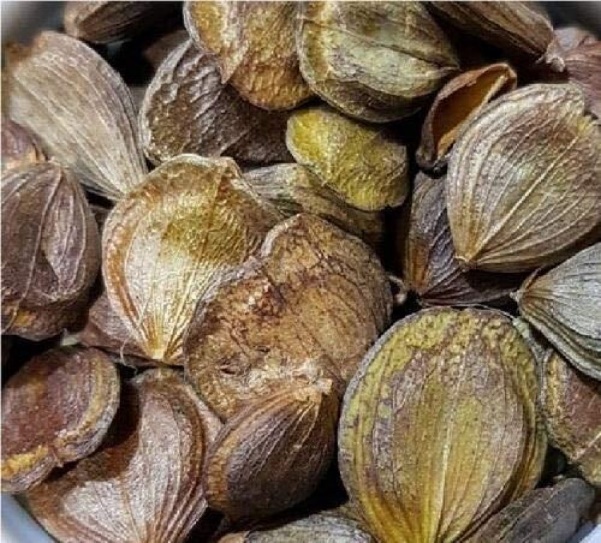
Fig 3 : Night Jasmine Seeds
C. Flowers
The flowers have several medicinal uses, including treating piles, various skin conditions, e ye conditions, and being carminative, astringent to the intestines, antibilious, expectorant, and toiletry. The vibrant orange corolla tubes of the flowers are colored with nyctanthin, wh ich is the same chemical as Crocetin derived from Saffron. Silk was previously dyed using th e corolla tubes, sometimes in conjunction with Turmeric or safflowe [13].
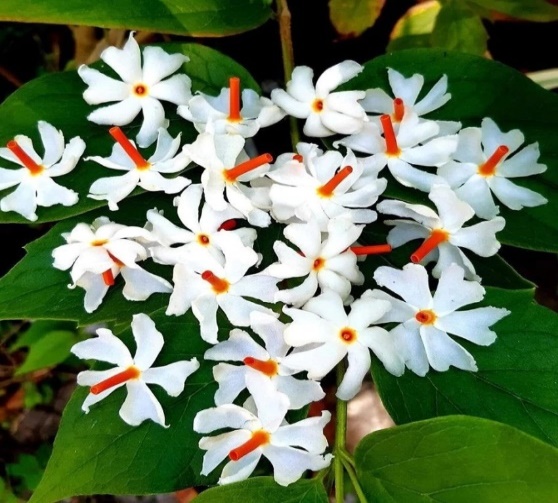
Fig 4: Night Jasmine Flower
D. Barks
The bark is used as a tanning agent, while the leaves are occasionally used to polish ivory and wood [13] . Glycosides and alkaloids found in the bark have multiple uses. Bark can occasionally be quite helpful healing wounds[14] .

Fig 5: Night Jasmine Bark
E. Stem
The stem is The branches have a sparse, coarsely hairy texture and are somewhat flexuous, bending and twining. (young adult) with short hair. These hairs are particularly noticeable on the smaller twigs. The stems have the Β-sitosterol and the glycosides naringenin-4-0-βglucapyranosyl-α-xylopyranosid [14] .
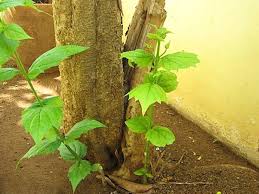
Fig 6: Night Jasmine Stem
VI. VARIOUS MORE INDUSTRIAL USE FOR THE PLANTS
- Essential oil: Used as a perfume, the oil found in fragrant blooms is comparable to that of jasmine
- Dyestuff: in the country, the In addition, dye is employed For adding colour to textiles and as a cheap alternative to The Buddhist clergymen’s garments with saffron.
- Wood: The wood is occasionally utilised for boards and Making a basket.
- Bark: The bark that is utilised as a tanning agent as well as Sometimes leaves are used to polish wood, and the Ivory.
- Fuel: Usually, the wood is utilised as fuel.
- Boundary, Barrier, and Support: it’s also incorporated into Bushes [15,16] .
VII. PHARMACOLOGICAL ACTIVITY
A. Anti-inflammatory Activity
anti-inflammatory properties Nyctanthes arbortristis' strong antiinflammatory action is one of its important therapeutic qualities. Extracts from the plant have demonstrated the capacity to lessen inflammation and its related symptoms. Iridoids, flavonoids, and phenolic acids are examples of bioactive substances that are thought to hav e an anti-inflammatory impact. These substances add to the plant's antiinflammatory properties by having inhibitory effects on a number of inflammatory mediator s [17].anti-inflammatory properties One of the significant medicinal properties of Nyctanthes arbortristis is its potent anti-inflammatory activity. The plant's extracts have shown the ability to reduce inflammation and alleviate associated symptoms. This antiinflammatory effect is attributed to the presence of bioactive compounds such as iridoids, flavonoids, and phenolic acids. These compounds exhibit inhibitory effects on various inflammatory mediators, contributing to the plant's antiinflammatory [18] .
B. Analgesic Activity
Analgesic characteristics Another well-known benefit of Nyctanthes arbortristis is its analgesic qualities, which help to reduce pain and suffering. Herbal treatments made from the plant's leaves and blossoms have been used for centuries to treat pain brought on by ailments like menstrual cramps, migraines, and arthritis. It is thought that the inhibition of inflammatory responses and modification of pain pathways influence the analgesic effect. Rephrase[19].
C. Gout, Dry Cough & Piles Treatment
Treatment for Gout, Dry Cough, and Piles: N. arbortristis seeds are used to cure piles. Gout i s treated using the flower decoction of N. arbortristis. Leaf tea is used to treat dry cough. The leaf paste with water is used. externally in the management of skinrelated issues, including ringworm. The tender foliage serve as a tonic for women Additionally, N. arbortristis has a hypoglycemic effect that amplifies the effects of exoge nous Rats with diabetes model caused by streptozotocin and insulin[20].
D. Antipyretic Properties
Moreover, Nyctanthes arbortristis is prized for its ability to reduce fever help lower the temperature. Conventional formulas that use the leaves and petals of the plant are used to regulate feverish circumstances and return the body to normal warmth. The potential antipyretic effect due to the plant's capacity to control the immunological reaction and prevent the release of compounds pyrogenic [21].
E. Anti-Viral Characteristics
Additionally, the plant has shown encouraging antiviral qualities, especially against certain strains of viruses. Numerous investigations have revealed the Nyctanthes arbortristis's inhibiting properties excerpts about the spread of viruses and their entrance into host cells. These antiviral characteristics belong to substantial enthusiasm for the prospective development of therapy for viral infections [22].
Conclusion
Practitioners utilised various sections of Nycanthus arbortritis Linn for a variety of illnesses in traditional medicine. The sarrow plant is used medicinally in many different ways. by its phytochemicals, which include glycosides and alkaloids, flavonoids, terpenes, and st eroids. Numerous pharmaceutical Activity of this plant has been demonstrated by studies. carried out for antiinflammatory, antiallergic, and antianxietyantinociceptive, anticholinesterase, antimalarial , antiparasitic, antiviral, antifilarial, antibacterial, antioxidant, anticancer, and antidiabetici mmune-suppressive, antipyretic, antianemic, CNS depressive, diuretic, and antiplasmodial br ancodilatorsedative, hepatoprotec tive, and used for piles gout, Dry cough, Constipation and Toxicity treatment.
References
[1] Hetal Bhalakiya, Nainesh R Modi. Traditional uses, phytochemical profiles and Pharmacological Activities of Nyctanthes arbot-tristis. Life science Informatics Publications March-April RJLBPS 5(2) page no. 1003 . [2] Puria, saxenar, saxenarp, saxena kc, srivastava v, Tandon js. Immunostimulant activity of nyctanthes Arbor-tristis L. Journal of Ethnopharmacology 1994;42(1):31-37. 3.KiewR&BaasP, NyctanthesisamemberofOleaceae, ProcIndianAcad Sci(Plant Sc.), 1984; 93(3): 349-358. [3] Milind M. Meshram, Swatee B. Rangari, Shashank B. Kshirsagar, Suraj Galbhiye, Nyctanthes Arbortristis. A Herbal Panacea in International Journal of Pharmaceutical Science Research UBSA (2012) VOL 3 Issue 8Suresh V, Jaikumar S, Arunachalam G “Antidiabetic activity of ethanolic extract of stem Bark of Nyctanthusarbortristis Linn”. Research Journal of pharmaceutical, biological and chemical Sciences, 2010; 1(4): 311- 317. [4] Himanshi Rawat, Yashika Verma, Ayesha, Neha Saini, Neha Negi, Hem Chandra Pant, Aditi Mishra, Mayank Singhal, Arzoo Khan, Naveen Gaurav “Nyctanthes arbor-tristis: A traditional herbal plant With miraculous potential in medicine” . [5] Jadhav Santosh, Patil Manojkumar, Nyctanthes Arbor-tristis Linn. Rejuvenating herbs.International Journal of Research in Pharmacy and Pharmaceutical A Sciences Volume 1 Issue 1: March 2016. Page No 54-62. [6] Azma, Waseem Ahmad, Asim Ali Khan and Mohhamad Fazil. Review on Nyctanthes Arbor-tristis (Harsinghar) – A Herbal Medicament with special references to Unani medicines. In Indian Journal of Unani medicines Volume XIV Issue – I P.P.61-68 Jan-June 2021. [7] Ganesh G Dhakad, Kaveri P Tambe, Sangita P Shirsath, Neha R Jaiswal. Review on medicinal uses of nyctanthes Arbor-tristis. In Research Journal of Pharmacology and Pharmacodynamics. Volume -14 Issue-3 Year-2022 . [8] Anuradha. S. N et al. “herbal review on nyctanthes Arbortristis linn. ” Rapports De Pharmacie, 2017; 3(1): 319-329. [9] Preeti Mishra et al. Harsingar plant and its species: Review on medicinal uses, therapeutics effects and Its importance, Advance Pharmaceutical Journal, 2022; 7(3): 67-72. [10] Ria Chakraborty, Santa Datta, A Brief Overview on The Health Benefits of Nyctanthes arbor-tristis Linn. A Wonder of Mother Nature, Indo Global Journal Of Pharmaceutical Sciences, 2022; 12: 197-204. [11] Sen, A. B., Singh, S. P.,. “Chemical examination of Nyctanthes arbor-trisitis. Journal of the Indian Chemical Society”, 1964; 41: 192–194 . [12] Shandhar, H.K., Kaur, M. An update on Nyctanthesarbor-tristis úLinn. Journal of Internationale Pharmaceutica Sciencia, 2011; 1: 77-86. [13] Singh A Malhotra, S. Subban R, Antiinflammatory and analgesic agents, from Indian Medicinal plants, International Journal of Intragative biology 2008, 5:250-58 . [14] Jyoti Agrawal et/al J Ethnopharmacol. Nyctanthes arbor- tristis Linn- A critical Ethnopharmacological review in National Liabrary of medicines. 2013 April 19;146(3): 645- 58 . [15] http://www. Efloras.org/florataxon.com visited on 04/05/2020. http://www.efloras.org/florataxon.aspx. [16] COUNCIL OS. The wealth of India. A dictionary of Indian raw materials and industrial products. N-Pe. 1966;7. [17] Jyoti Agrawal et/al J Ethnopharmacol. Nyctanthes arbor- tristis Linn- A critical Ethnopharmacological review in National Liabrary of medicines. 2013 April 19;146(3): 645- 58. [18] Bhalakiya, H., & Modi, N. R. (2019).Traditional medicinal uses,Phytochemical profile and Pharmacological activities of Nyctanthes Arbortris. RJLBPCS, 5, 1003-1023. [19] Sharma, L., Dhiman, M., Singh, A., & Sharma, M. M. (2021). Nyctanthes arbortristis.:“An Unexplored Plant of Enormous Possibilities for Economic Revenue”.Proceedings of the National Academy of Sciences, India Section B: Biological Sciences, 91, 241-255. [20] Talakal TS, Dwivedi SK and Sharma SR. Invitro-Invivo antitrypanosomal potential of Nyctanthes Arbor-tristis Leaves, Pharmaceutical Bio, 2000 38(5) 326-329 [21] Parekh, S., & Soni, A. (2020). Nyctanthes arbor-tristis: Comprehensive Review on its pharmacological, Antioxidant, and anticancer activities. Journal of Applied Biology and Biotechnology, 8(1), 95-104. [22] Bhadra, P. (2020). Efficacy of some Compounds isolated from Nyctanthes Arbortristis Linn. On human and plant Diseases as revealed from in silico Analysis. Indian Journal of Natural Sciences, 10(60), 20833-20839
Copyright
Copyright © 2024 Leena Tamnar, Komal Bhoir, Akshada Vartha, Rahul Jagdale. This is an open access article distributed under the Creative Commons Attribution License, which permits unrestricted use, distribution, and reproduction in any medium, provided the original work is properly cited.

Download Paper
Paper Id : IJRASET64702
Publish Date : 2024-10-20
ISSN : 2321-9653
Publisher Name : IJRASET
DOI Link : Click Here
 Submit Paper Online
Submit Paper Online

